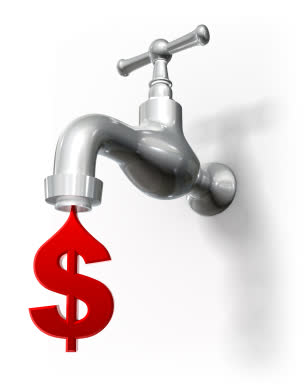Dividend Value Builder Newsletter
– Discover, Compare, and Evaluate Dividend Stocks Without Emotional Bias –
(Intrinsic Value Analysis For Over 300 Stocks)
Cash Flow From Operations (CFO) Calculations & Ratios



Cash Flow From Operations (CFO) is the cash inflows and outflows of a company’s core business operations. It is an important line on the cash flow statement.
The cash flow statement defines three types of cash flow: cash flow from operations, cash flow from investing activities, and cash flow from financing. These 3 types of cash flow totaled equal Total Cash Flow.
Cash Flow From Operations provides a measurement of cash inflows and outflows for a specific period of time, usually quarterly or annually. CFO excludes cash flows from investing and financing in order to focus on the cash flows for the ongoing operations which will determine the long term success of the company.
My fundamental analysis of intrinsic value relies heavily on cash flow from operations to help determine the “real” worth of a company stock.
Cash Flow From Operations (CFO) Calculation
Cash Flow From Operations (CFO) = (a) Net Income + (b) Depreciation & Amortization +/- (c) One-Time Adjustments +/- (d) Change in Working Capital
Components of CFO:
Net Income – Found in the company’s Income Statement
Net income is an accounting metric that includes items that don’t affect cash. Therefore we need to make adjustments to figure cash flow.
(b) Depreciation & Amortization – Non-cash item found as a Cash Flow Statement line item.
When a company purchases long lived assets they are required to amortize (spread) the cost over a number of years. However, this does not reduce their cash, it is only an accounting expense. Therefore you need to add this expense back into net income to calculate cash flow.
(c) One-Time Adjustments – Found as line items in the Cash Flow Statement. Many times these will be listed separately in the income statement.
One time adjustments could include non-cash items such as deferred taxes, investment gains/losses not related to operations, stock based compensation to employees, etc.)
(d) Changes in Working Capital – Found as line items in the Cash Flow Statement. The components of working capital are balance sheet items.
Working Capital is current assets – current liabilities. You could calculate working capital from the balance sheet even if you didn’t have a cash flow statement.
Purpose of Cash Flow From Operations (CFO)
The cash flow from operations is detailed first in the cash flow statement and tells you how much cash flow has been generated by the core operations of the business, as opposed to secondary activities such as investing and financing. In the long run cash flow from operations must be positive for the company to remain solvent.
Investing and financing activities are usually cash flow negative, making positive cash flow from operations essential in the long run. It is cash flow from operations that will be used to make capital expenditures, design new products, make acquisitions (investing activities), pay dividends, buy back stock, and/or reduce debt (financing activities).
The purpose of defining Cash Flow From Operations is to isolate and focus on the well-being of the day-to-day operations or core business of the company. It is the lifeblood of the organization, making it one of the most important metrics an analyst can examine.
Cash Flow From Operations Ratios
1. CFO Enterprise Multiple
EV to CFO = Enterprise Value (EV) / Cash Flow From Operations (CFO)
(When comparing similar companies a lower ratio would be a better value than a higher ratio.)
or turn it around to get the CFO Enterprise Yield…..
CFO Enterprise Yield = Cash Flow From Operations (CFO) / Enterprise Value (EV)
(When comparing similar companies a higher yield would indicate a better value than a lower yield.)
2. Cash Return On Assets Ratio
Cash Return On Assets = Cash Flow From Operations (CFO) / Total Assets
(A higher ratio is better than a lower ratio when analyzing two similar companies.)
Cash Return on Assets tells how efficient a company is at employing its assets. A high return may signal a bright future for the company because they will have more cash flow to reinvest for growth and to return to shareholders.
3. Cash Flow to Debt Ratio
Cash Flow to Debt Ratio = Cash Flow From Operations / Total Debt
(A high ratio is better than a low ratio when analyzing two similar companies.)
or turn the ratio around….
Total Debt / Cash Flow From Operations
(This ratio tells you how many time periods (usually years) it would take to pay off company debt if all the cash flow from operations was used to pay down debt.)
4. Capital Expenditure Ratio
Cash Flow to Capital Expenditures Ratio = Cash Flow From Operations / Capital Expenditures
(When comparing similar companies a higher ratio would indicate the better ability to make additional capital expenditures without issuing more debt or equity. An increasing ratio over time would indicate a company has the ability to grow internally.)
Conclusion
Cash Flow From Operations (CFO) may be the single most important metric in company analysis. Using CFO in ratios provide analysis critical to making good investment decisions.
Related Reading:
Intrinsic Value Stock Analysis – My Formula
Minimize Large Portfolio Drawdowns
Invest With Confidence in Less Time - Manage Your Portfolio Without Behavioral Errors
